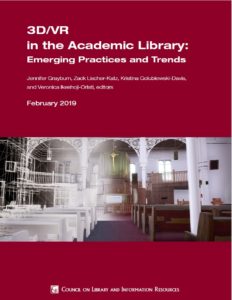Contact: Kathlin Smith
Arlington, VA, February 26, 2019—A new CLIR report, 3D/VR in the Academic Library: Emerging Practices and Trends, examines the use of three-dimensional (3D) and virtual reality (VR) technologies in research and teaching, and the library’s vital role in supporting this work.
 3D modeling, 3D capture techniques, and VR enable faculty and students to engage with highly detailed 3D data—from cultural heritage artifacts to scientific simulations—in new ways. A professor can take students on an immersive field trip to Stonehenge, changing the lighting to simulate various phases of solar events. A biochemistry researcher may explore complex protein structures with students, or a chemical engineer may simulate the movement of fluids in various porous rock materials.
3D modeling, 3D capture techniques, and VR enable faculty and students to engage with highly detailed 3D data—from cultural heritage artifacts to scientific simulations—in new ways. A professor can take students on an immersive field trip to Stonehenge, changing the lighting to simulate various phases of solar events. A biochemistry researcher may explore complex protein structures with students, or a chemical engineer may simulate the movement of fluids in various porous rock materials.
“As 3D and VR projects scale up and move outside of the specialist disciplines where they have existed for decades, questions arise concerning skills development, interdisciplinary collaboration, publication, sustainability, preservation, and reuse,” notes the report. Many academic libraries are taking the lead in supporting these projects because they are already centers for collaboration, instruction, research, and collection preservation. Libraries are providing training opportunities, hiring staff to provide services in support of research projects, and working to create a community-wide framework for preservation. Supporting these technologies furthers the library’s mission to provide constituencies access to scholarly information in all forms and formats.
The volume grew out of an interdisciplinary conference, 3D/VR Creation and Curation in Higher Education: A Colloquium to Explore Standards and Best Practices, held in March 2018 at the University of Oklahoma. Organized by the volume’s editors Jennifer Grayburn, Zack Lischer-Katz, Kristina Golubiewski-Davis, and Veronica Ikeshoji-Orlati—then CLIR postdoctoral fellows working in academic libraries—the colloquium aimed to “identify points of tension and gaps in existing practices and knowledge to foster common understanding for the librarians and digital curators tasked with supporting and managing these new data types.” The conference and publication were funded by the Alfred P. Sloan Foundation through a CLIR microgrant, with institutional support from the University of Oklahoma Libraries, Temple University Libraries, and University of California Santa Cruz University Library.
The volume seeks to prompt greater awareness for library professionals as they develop programs that use 3D and VR technologies and work to integrate changing scholarly demands and conventions with existing library services and policies. Eight chapters contributed by experts in a variety of fields cover 3D content creation, VR visualization and analysis, 3D/VR-based educational deployment, and 3D/VR data curation, providing a snapshot of professional objectives and workflows that have developed around 3D/VR. Together, the chapters highlight three critical approaches for librarians and digital curators to consider as they use 3D/VR to support their communities: (1) treat the academic outputs that use 3D/VR as scholarly products; (2) build a 3D/VR scholarly community to support knowledge exchange across a range of stakeholder groups; and (3) develop technical tools, training, and infrastructure to support a 3D/VR research ecosystem.
The report is available at https://www.clir.org/pubs-reports-pub176/.
CLIR is an independent, nonprofit organization that forges strategies to enhance research, teaching, and learning environments in collaboration with libraries, cultural institutions, and communities of higher learning. It aims to promote forward-looking collaborative solutions that transcend disciplinary, institutional, professional, and geographic boundaries in support of the public good.

